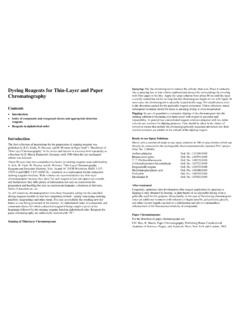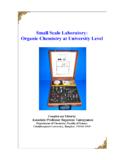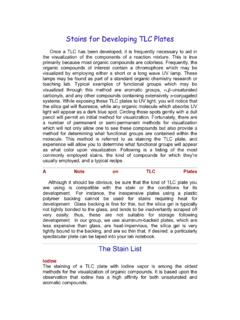Transcription of TLC and HPTLC fingerprinting of leaf extracts of …
1 ~ 29 ~ Journal of Pharmaco gnosy and Phytochemistry 2014; 2 (6): 29-33 ISSN 2278-4136 ISSN 2349-8234 JPP 2014; 2 (6): 29-33 Received: 21-01-2014 Accepted: 25-01-2014 Rehana Banu, H Department of Botany, Nirmala College for Women, Coimbatore, Tamil Nadu, India. Email: N. Nagarajan Department of Botany, Kongunadu Arts and Science College, Coimbatore, Tamil Nadu, India. Email: Correspondence: Rehana Banu, H Department of Botany, Nirmala College for Women, Coimbatore, Tamil Nadu, India. Email: Tel: +919629226949 TLC and HPTLC fingerprinting of leaf extracts of Wedelia chinensis (Osbeck) Merrill. Rehana Banu, H., N. Nagarajan ABSTRACT Objective: To establish the fingerprint profile of Wedelia chinensis using thin layer chromatography (TLC) and high performance thin layer chromatography ( HPTLC ) technique.
2 Methods: TLC and HPTLC studies were carried out in two different solvent systems, which showed different Rf value. Results: TLC profiling of the extract confirm about the presence of various phytochemicals. HPTLC finger printing of methanol extract of leaf revealed various peaks with Rf values in the range of to Conclusion: It can be concluded that different Rf value of various phytochemicals provide valuable clue regarding their polarity and selection of solvents for separation of phytochemicals. The study will help in future for identifying this plant for further research. Keywords: Wedelia chinensis, profile, TLC, HPTLC fingerprinting . 1. Introduction India has one of the oldest, richest and most diverse cultural traditions associated with the use of medicinal plants. This knowledge is accessible from thousands of medical texts and manuscripts.
3 The substances having medical value have been extensively used for treating various disease conditions. Herbs being easily available to human beings have been explored to the maximum for their medicinal properties. Products of primary metabolism such as aminoacids, carbohydrates and proteins are vital for the maintenance of life processes, while others like alkaloids, phenolics, steroids, terpenoids are products of secondary metabolism and have toxicological, pharmacological and ecological importance [1]. Many medicinal plants, traditionally used for thousands of years, are present in a group of herbal preparations of the Indian traditional health care system, (Ayurveda) and proposed for their interesting multilevel activities. Amongst the medicinal plants used in Ayurvedic preparations for their therapeutic action, some have been thoroughly investigated and some of are still to be explored [2].
4 There are many families of phytochemicals which help the human body in variety of ways. Phytochemicals may protect human from a host of disease. Phytochemicals are non- nutritive plant chemicals that have protective or disease preventive properties. Plant produces these chemical to protect itself but recent research demonstrates that many phytochemicals can protect humans against disease. There are many phytochemicals in fruit and shrubs and each work differently [3]. The phytochemical evaluations of plants which have a suitable history of use in folklore have often resulted in the isolation of principles with remarkable bio-activities [4]. Hence, methodologies that can generate a fingerprint of each extract in large collections would be useful to detect stability of the same extract over time.
5 Preferably, the method should be based on electronic storage, retrieval and analysis of the data [5]. A lot of extraction methods and analytical methods as spectrophotometry, high performance thin layer chromatography ( HPTLC ), high performance liquid chromatography (HPLC), gas chromatography -mass spectrometry (GC MS) and Fluorescence Transmission-Infrared Spectroscopy (FT-IR) are developed for the study about plant active compounds [6]. High-performance thin layer chromatography ( HPTLC ) based methods could be considered as a good alternative, as they are being explored as an important tool in routine drug analysis. Major advantage of HPTLC is its ability to analyze several samples simultaneously using a small quantity of mobile phase. ~ 30 ~ Journal of Pharmacognosy and Phytochemistry This reduces time and cost of analysis.
6 In addition, it minimizes exposure risks and significantly reduces disposal problems of toxic organic effluents, thereby reducing possibilities of environment pollution. HPTLC also facilitates repeated detection of chromatogram with same or different parameters [7, 8]. Wedelia chinensis (Osbeck) Merrill is a perennial herb of family Asteraceae, commonly known as Pilabhamgara or Bhringraj in Hindi, Wedelia in Chinese and Manjal karisalanganni in Tamil [9]. Traditionally, the fruits, leaves and stem are used in child birth and in the treatment of bites and stings, fever and infection. The leaves are used in the treatment of kidney dysfunction, cold, wounds and amenorrhea [10]. The leaves are also for dyeing hair and for promoting their growth. The tonic of the leaves is used in cough and cephalalgia. Decoction of the plant is used in menorrhagia and skin diseases [11, 12].
7 The main objective of this study was to evaluate and optimize the HPTLC fingerprint method in standardization of Wedelia chinensis to provide beneficial information in regarding the standardization according to WHO guidelines. These HPTLC fluorescence images coupled with scanning profiles provided adequate information and parameters for comprehensive identification, assessment and comparison of major active constituent fingerprints in the samples studied to serve as a basis for their use in medicinal preparations. 2. Materials and Methods Collection, identification and preparation of plant materials The plant specimen Wedelia chinensis (Osbeck) Merrill leaves were collected from Attakatti Hills, Western Ghats, India and authenticated by Dr. V. Balasubramanian, Associate Professor, Department of Botany, Kongunadu Arts and Science College, Coimbatore, Tamilnadu, India and was deposited at the college herbarium (Voucher Specimen No: KASC435).
8 The leaves were washed, shade dried and is made powder mechanically and the fine powder was used for extraction procedure. Preparation of extracts 50 g of the shade dried and powdered leaf material was taken for extraction. The crude drug powder was subjected for extraction (Soxhlet extraction) in round bottom flask, first with petroleum ether (60 80 0C) for 24 hours [13, 14] followed by successive extraction with different solvents ranging from non-polar to polar organic solvents namely chloroform, ethyl acetate and methanol separately. The extracts were filtered over Whatman No. 1 filter paper, and the filtrates were concentrated under reduced pressure to pasty mass [15] for further studies. thin Layer chromatography (TLC) TLC studies were carried out following the methodology of Wagner [16] et al.
9 Procedure: Glass capillaries were used for spotting TLC plate. Silica gel plate having the size of 5 20 cm was taken and it was marked using pencil. Firstly, straight line was drawn parallel to the short dimension of the plate, cm from one end of the plate. Secondly, two small marks were made perpendicularly to this line to divide the line. The distance between the spots was cm while the distance of the spot from the margin of plant was cm. These marks served as a guide for placing the extracts of the plant. Silica gel G was used as the adsorbent. Slurry of it was prepared with distilled water and was poured on the clean and dry glass plates and spread on the plate as a uniform coating using a glass rod. These plates were allowed to air dry for 20-25 minutes. Spots (leaf extract) were applied on the activated plate at a distance of 2 cm from one end of the plate with the help of a wing micropipette.
10 While developing the plate, the solvent front was allowed to rise to the second line. Then the solvent was allowed to completely evaporate from the spot. Second deposit was made on same spot. Again the solvent was allowed to completely evaporate. The spotted plates were put in a chromatographic solvent chamber which contained various solvent systems where they placed in such a way that the loaded spot should not touch the solvent. The chamber was covered with proper lid and then it was allowed to stand for sufficient time to reach the solvent phase at maximum. When the solvent front reached second line on plate, it was taken out and dried at room temperature [17, 18]. After the separation of phytochemicals, specific spray reagents were sprayed and allowed to dry. The coloured spots developed on the stationary phase were marked and identified by specific reagent and their distances were measured.

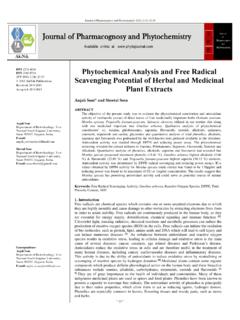
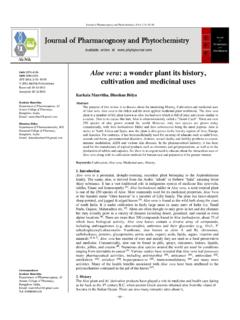



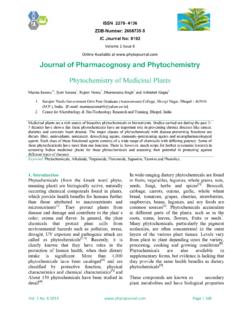


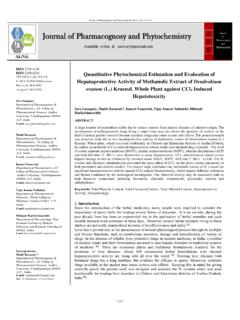
![[RuCl2 η6 p cymene)]complexes bearing …](/cache/preview/f/9/0/e/a/d/5/b/thumb-f90ead5b7a85e5f2b7589de823c9233c.jpg)
